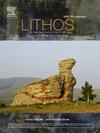A Precambrian basement beneath the King George Island (Antarctica Peninsula) revealed by zircon xenocrystals from Eocene to Miocene volcanic rocks
IF 2.9
2区 地球科学
Q2 GEOCHEMISTRY & GEOPHYSICS
引用次数: 0
Abstract
Our knowledge of the Precambrian geological records of the deep crust beneath the Antarctic Peninsula is still sparse. The King George Island located in the northwestern part of the South Shetland Islands (Antarctic Peninsula) is mainly covered by the Cenozoic volcanic and intrusive rocks. This study presents new petrological, geochronological (LA-ICP-MS zircon U![]() Pb dates), and geochemical data from the King George Island volcanic rocks. The accidental discovery of zircon xenocrysts within these volcanic rocks offers valuable insights into the composition of the deep crust in the region. The zircon ages indicate the evidence of a Proterozoic to Cambrian basement in the King George Island. Among them, 56 zircons with 90–99 % concordance yielded ages ranging from 101 ± 1.7 Ma to 2407 ± 46 Ma. Major age peaks were identified approximately ca. 1.8–1.6 Ga, ca. 1.2–0.75 Ga, and ca. 0.55–0.5 Ga. These zircon xenocryst populations show age ranges and εHf(t) values similar to those of basement rocks of the South America (Patagonia) continental block. This similarity suggests that the Proterozoic to Cambrian Patagonia crustal fragments may extend into the King George Island, South Shetland Islands (Antarctic Peninsula). Accordingly, we consider the paleogeographic position of the South Shetland Islands was probably at the southwestern end of the South America, forming the southwestern margin of Gondwana during the Early Mesozoic.
Pb dates), and geochemical data from the King George Island volcanic rocks. The accidental discovery of zircon xenocrysts within these volcanic rocks offers valuable insights into the composition of the deep crust in the region. The zircon ages indicate the evidence of a Proterozoic to Cambrian basement in the King George Island. Among them, 56 zircons with 90–99 % concordance yielded ages ranging from 101 ± 1.7 Ma to 2407 ± 46 Ma. Major age peaks were identified approximately ca. 1.8–1.6 Ga, ca. 1.2–0.75 Ga, and ca. 0.55–0.5 Ga. These zircon xenocryst populations show age ranges and εHf(t) values similar to those of basement rocks of the South America (Patagonia) continental block. This similarity suggests that the Proterozoic to Cambrian Patagonia crustal fragments may extend into the King George Island, South Shetland Islands (Antarctic Peninsula). Accordingly, we consider the paleogeographic position of the South Shetland Islands was probably at the southwestern end of the South America, forming the southwestern margin of Gondwana during the Early Mesozoic.
求助全文
约1分钟内获得全文
求助全文
来源期刊

Lithos
地学-地球化学与地球物理
CiteScore
6.80
自引率
11.40%
发文量
286
审稿时长
3.5 months
期刊介绍:
Lithos publishes original research papers on the petrology, geochemistry and petrogenesis of igneous and metamorphic rocks. Papers on mineralogy/mineral physics related to petrology and petrogenetic problems are also welcomed.
 求助内容:
求助内容: 应助结果提醒方式:
应助结果提醒方式:


